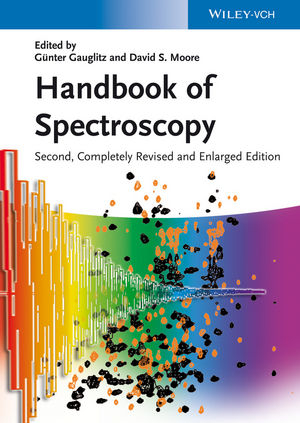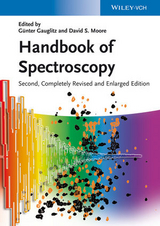Handbook of Spectroscopy
Wiley-VCH (Verlag)
978-3-527-32150-6 (ISBN)
- Titel ist leider vergriffen;
keine Neuauflage - Artikel merken
This second, thoroughly revised, updated and enlarged edition provides a straightforward introduction to spectroscopy, showing what it can do and how it does it, together with a clear, integrated and objective account of the wealth of information that may be derived from spectra. It also features new chapters on spectroscopy in nano-dimensions, nano-optics, and polymer analysis.Clearly structured into sixteen sections, it covers everything from spectroscopy in nanodimensions to medicinal applications, spanning a wide range of the electromagnetic spectrum and the physical processes involved, from nuclear phenomena to molecular rotation processes.In addition, data tables provide a comparison of different methods in a standardized form, allowing readers to save valuable time in the decision process by avoiding wrong turns, and also help in selecting the instrumentation and performing the experiments.These four volumes are a must-have companion for daily use in every lab.
Professor Günter Gauglitz has published over 260 publications on photokinetics, UV-VIS spectroscopy, chromatographic detection, optical sensors, modification and characterization of boundary layers, and many more topics. He is the author of several books on practical spectroscopy, and basics and applications in photokinetics, among chapters on sensors and surface modifications. He is holder of more than 10 patents. He received the Wallac Award of the Society of Biomolecular Screening in 1997, the Pregl Medal of the Austrian Chemical Society in 2006 and the Carl-Duisberg-Medal of the German Chemical Society in 2012. Dr. David S. Moore received the 2009 Los Alamos Fellows Prize for Leadership and is a Fellow of the International Union of Pure and Applied Chemistry (2011) and the American Physical Society (2004). He was also an Alexander von Humboldt Fellow (Essen 1993-94). Moore's research involves the use of nonlinear optical and ultrafast spectroscopies to understand the behavior of molecules under shock compression, the use of Raman, coherent Raman, and surface enhanced Raman methods for trace explosives detection and identification, the application of coherent control methods for condensed phase chemistry (explosive initiation) and explosives detection, and the development of remote stimulation methods to detect explosives via alternative signatures. He is presently a Research Scientist and Group Leader at Los Alamos, is author of more than 180 publications and seven book chapters, and is the holder of five patents
Volume 1
SECTION I: SAMPLE PREPARATION AND SAMPLE PRETREATMENT
Preparation of Liquid and Solid Samples
Liquid and Solid Sample Collection
SECTION II: METHODS 1: OPTICAL SPECTROSCOPY
Basics of Optical Spectroscopy
Instrumentation
Measurement Techniques
Applications
SECTION III: METHODS 2: NMR
An Introduction to Solution, Solid-State, and Imaging NMR Spectroscopy
Solution NMR Spectroscopy
Suspended-State NMR Spectroscopy (High-Resolution Magic Angle Spinning (HR-MAS) NMR Spectroscopy)
Solid-State NMR
SECTION IV: METHODS 3: MASS SPECTROMETRY
Mass Spectrometry
Multiparametric Analysis of Mass Spectrometry-Based Proteome Profiling in Gestation-Related Diseases
Laser-Assisted Mass Spectrometry
Volume 2
SECTION V: METHODS 4: ELEMENTAL ANALYSIS
X-Ray Fluorescence Analysis
Atomic Absorption Spectrometry (AAS) and Atomic Emission Spectrometry (AES)
Inductively Coupled Plasma Spectrometry
Laser Ablation Inductively Coupled Plasma Mass Spectrometry (LA-ICPMS)
SECTION VI: METHODS 5: SURFACE ANALYSIS
Electron Probe Techniques
Ion/Neutral Probe Techniques
Photon Probe Techniques
SECTION VII: METHODS 6: SPECTROSCOPY IN NANO DIMENSIONS
Single Molecule Spectroscopy
Single-Molecule Interfacial Electron Transfer Dynamics
Scanning Near-Field Gap-Mode Microscopy
Volume 3
SECTION VIII: APPLICATIONS 1: BIOANALYSIS
Trends in Bioanalytical Spectroscopy
Quality Assessment of Spectroscopic Methods in Clinical Laboratories
UV-Vis and NIR Fluorescence Spectroscopy
Principles of Vibrational Spectroscopic Methods and their Application to Bioanalysis
Bioanalytical NMR Spectroscopy
Direct Optical Spectroscopy
SECTION IX: APPLICATIONS 2: POLYMER ANALYSIS
Surface Plasmon Spectroscopy Methods and Electrochemical Analysis
Applications of Fourier Transform Infrared (FTIR) Imaging
Photon Correlation Spectroscopy Coupled with Field-Flow Fractionation for Polymer Analysis
Surface Plasmon Resonance Spectroscopy and Molecularly Imprinted Polymer (MIP) Sensors
SECTION X: APPLICATIONS 3: ENVIRONMENTAL ANALYSIS
LC-MS in Environmental Analysis
Ion Attachment Mass Spectrometry for Environmental Analysis
Immunoassays
SECTION XI: APPLICATIONS 4: PROCESS CONTROL
Process Control in Chemical Manufacturing
Process Control Using Spectroscopic Tools in Pharmaceutical Industry and Biotechnology
Applications of Optical Spectroscopy to Process Environments
Spectral Imaging in Quality and Process Control
Trends in Spectroscopic Techniques for Process Control
Volume 4
SECTION XII: APPLICATIONS 5: SPECTROSCOPY AT SURFACES
Optical Spectroscopy at Surfaces
NEXAFS Studies at Surfaces
The X-Ray Standing Wave Technique
Photonelectron Spectroscopy Applications to Materials Science
SECTION XIII: Applications 6: Nano-Optics
Miniaturized Optical Sensors for Medical Diagnostics
Tip-Enhanced Near-Field Optical Microscopy
Optical Waveguide Spectroscopy
SECTION XIV: HYPHENATED TECHNIQUES
Mass Spectral Detection
Optical Detection
Atomic Spectral Detection
NMR as a Chromatography Detector
SECTION XV: GENERAL DATA TREATMENT: DATA BASES/SPECTRAL LIBRARIES
Optical Spectroscopy
Nuclear Magnetic Resonance Spectroscopy
Mass Spectrometry
Raman Spectroscopy Fundamentals
Index
"Die Anschaffung lohnt sich."
Dr. Norbert Höfert, Gefahrstoffe - Reinhaltung der Luft 1/2-2004
"... This is a suitable reference book for any practitioner in spectroscopic analysis and we would recommend it for any scientific library."
Gang Ma and Heather C. Allen, Ohio State University
| Erscheint lt. Verlag | 30.4.2014 |
|---|---|
| Verlagsort | Weinheim |
| Sprache | englisch |
| Maße | 170 x 244 mm |
| Gewicht | 5255 g |
| Themenwelt | Naturwissenschaften ► Chemie ► Analytische Chemie |
| Schlagworte | Analytical Chemistry • Analytische Chemie • Chemical Analysis / Sample Preparation • Chemie • Chemische Analyse • Chemische Analyse / Probenvorbereitung • Chemistry • Massenspektrometrie • Mass Spectrometry • NMR Spectroscopy / MRI / Imaging • NMR-Spektroskopie / MRT / Bildgebende Verfahren • spectroscopy • Spektroskopie |
| ISBN-10 | 3-527-32150-0 / 3527321500 |
| ISBN-13 | 978-3-527-32150-6 / 9783527321506 |
| Zustand | Neuware |
| Haben Sie eine Frage zum Produkt? |
aus dem Bereich




